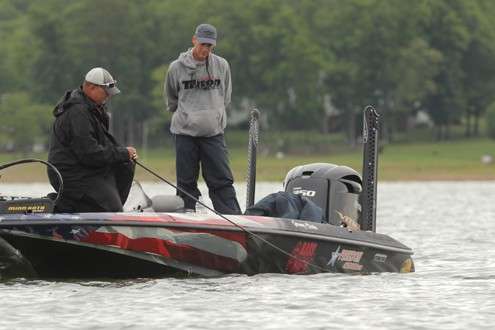
DANDRIDGE, Tenn. — Jeremy Starks has been making incredibly long casts with a crankbait to catch bass schooled in the depths of Douglas Lake this week. Would you believe 300 yards long?
Technically, it's not a cast that Starks is making to reach the 35- and 40-foot depths where the fish are holding. Around Douglas Lake, the technique is called "long-lining."
And it's what Starks has done to catch his second-place total of 58 pounds, 13 ounces over the first three days of the Bassmaster Elite Series Douglas Lake Challenge.
"That's how I've caught every one of them," said the Scott Depot, W.Va., angler.
Kelly Jordon of Palestine, Texas, nicknamed the technique "strolling" when he led his team to the championship in the Toyota Texas Bass Classic on Lake Fork a few years ago.
Here's the deal: You cast a crankbait as far as you can on 8- to 12-pound-test fluorocarbon line, then leave the reel in free spool as you troll in the opposite direction. When there's barely any line left on the reel, you stop the boat and start reeling.
"I've got 300 yards on one reel, and I'm getting it all off," Starks said.
Starks is hardly the only angler long-lining crankbaits at Douglas Lake in this tournament.
"I've really not done it a whole lot, but I'm doing it this week," said Brandon Card of nearby Caryville, Tenn. "I should have done it last year (here), but I didn't, and it cost me a lot.
"This week I've just been experimenting with it."
Card has experimented with it well enough to make the top 12 cut for Sunday's final. He's in ninth place with 48-8.
Jordon was kicking himself Saturday for not getting on the pattern earlier in the week. He finished 17th with 42-2.
"It's kind of a secret deal," Jordon said. "It's just a way to catch fish with a crankbait that are inaccessible fishing any other way.
"I've done that for years on Lake Fork. You can't cast any unmodified crankbait that I know of and hit 25 (feet) plus. If you can, when your bait is finally getting down there, it's almost ready to start coming back up.
"It's unbelievable how deep you can get them down there if you can get a lot of line out. And you can keep that crankbait in the strike zone."
Jordon did have time to refine the technique a bit this week.
"I was able to hit depths that I've never hit before," he said. "I know because there were times when I didn't catch a fish and the crankbait would have red clay on it."
What depths was he reaching?
"I'd rather not say," Jordon replied.
Jordon has made popular another deep-bassing technique, using a jumbo-size spoon, a Lake Fork Spoon, in particular. And swimbaits have added another deep-water technique to a bass angler's tackle box. But this deep-cranking style is something special, apparently. Many of the pros that made Sunday's final at Douglas Lake are long-lining, including leader Britt Myers.
"A lot of times deep fish will bite a crankbait better than anything you can throw," Jordon said. "And a lot of times a crankbait can catch bigger fish than anything you can throw."
As in many Elite Series events, catching a five-bass-limit hasn't been a problem here. It's triggering bigger fish that separates the field.
"A lot of these guys have little tricks the regular fishing community doesn't know about," Starks said. "Now they're going to know about this one. It's just one of those things that if you spend enough time on the water, you figure out. I think guys have been doing this professionally for quite a few years."
Card makes the technique sound simple.
"If I see (a bass) on my (sonar) graph, I'll just launch a cast and try to line it up," he said. "Then when I (troll) to where I think is far enough, I just stop and start cranking it right down there. About halfway back, you catch 'em."
Trolling isn't allowed in Bassmaster tournaments. But this isn't trolling. The trolling motor is used to simply, in essence, lengthen the cast. Card isn't using nearly as much line as Starks.
"It's probably about a hundred yards," Card said. "There's not much left on the spool."
Fluorocarbon line, which sinks, is one of the keys to the technique.
"When you do this and use the right line, your line will sink to the bottom and you can kind of track it around down there," Starks said. "You can find those fish and pull it through them."
Any deep-diving crankbait will work. But one has been a particular favorite this week, according to Starks.
"It's no secret," he said. "Everybody is throwing a Strike King Series 6. It didn't seem to matter what color."
The thing that matters is a long line — a very, very long line.
